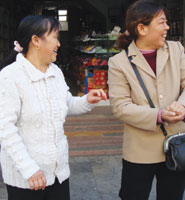Prior to the 1970s strict limits had been imposed on ordinary Chinese citizens, making it hard for them to change their permanent place of residence. But beginning with the reform period in the late 1970s and accelerating during the late 1990s, national and local authorities relaxed restrictions on obtaining urban residence permits. While these moves are a step forward, recent reforms often include high income and strict housing requirements that work against rural migrants seeing to move to China’s cities. Migrants who do not meet these requirements usually cannot obtain public services such as health care and schooling for their children on an equal basis with other residents. These uneven reforms discriminate against poor migrant workers in favour of the wealthy and educated, having replaced the restrictions on changes in permanent residence with a barrier preventing some of China’s most vulnerable citizens from receiving public services.
In 2002 the number of peasant workers employed in the industrial and service sectors in China reached 92 million
Despite these disadvantages, in 2002 the number of peasant workers employed in the industrial and service sectors in China reached 92 million, exceeding the number of employees in state and collectively owned enterprises (87 million). The number has subsequently risen to around 120 million, accounting for 16 per cent of the entire labour force in China. Among them, 80 per cent work in the industrial, construction, catering and service industries. These figures indicate that peasant workers have become the mainstream of the Chinese industrial working class.
The focus of this study was Dongguan, chosen because it is a key industrial city in the Pearl River Delta in Guangdong Province, southern China, which hosts over two million peasant workers who come from adjacent provinces to engage primarily in industrial manufacturing. A number of peasant workers were asked, through focus groups and face-to-face interviews, what they thought about their new social status and whether they felt part of a new urban citizenship. Interestingly, while a large majority (93 per cent) believed that they had benefited from the economic reforms, as many as 25 per cent considered that no major change had occurred in their social status. Of these, 80 per cent chose to go back to their rural homes after finishing work rather than stay in the city, and even amongst those who did consider that their social status had improved, the majority (67 per cent) still preferred to go back home after working in the city. This clearly demonstrates that few peasant workers have so far developed any strong sense of belonging to their new communities – indeed, only 30 per cent believed they would become ‘New Dongguan citizens’ in urban China. This idea appears to have found little resonance among these workers, particularly since they have not seen any concrete policy measures which – in terms of social protection or welfare entitlements – would guarantee them treatment equal to that enjoyed by locally born residents.
Workers have been deceived by employers who fail to pay their salaries regularly
However, having made contributions to local economic and social developments, some of these workers have now begun to show interest in having their social rights protected. Although they have not yet organised themselves into a force strong enough to demand better social protection, they do expect the government to enforce laws to make sure their employers pay them regularly, and there is a growing expectation that the government should provide better education opportunities for their children, as well as social housing, medicare and other social welfare services.
While most of the participants in the study knew of the existence of a trade union in their firms, less than ten per cent were active members of a union and less than 20 per cent felt a trade union would be helpful to them. More interestingly, only eight per cent chose to reply to questions about whether they would participate in sit-ins or strikes to negotiate with their employers, and no respondents would reply to questions regarding demonstrations or other relatively radical means of settling labour-related issues. So for the moment it appears that workers prefer internal channels within the companies to resolve most of their labour disputes.
But with the shortage of labour in the Guangdong area, local governments should take peasant workers’ social welfare concerns very seriously, especially since many found the notion of ‘New Dongguan citizens’ an empty one. In particular, a growing number of workers have been deceived by employers who fail to pay their salaries regularly or even cut salaries without reasonable grounds, so if the workers were to become more organised in the future, it would have significant social and political consequences. The government would therefore be well advised not to ignore the growing complexity of relations between the state, employers and peasant workers.

